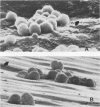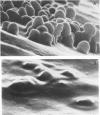Abstract
Scanning electron microscopy was used to assess the morphological features of coagulase-negative staphylococci adherent to polyvinylchloride intravascular catheter specimens. Clinical specimens were obtained by using patient catheters from which coagulase-negative staphylococci (greater than or equal to 15 colonies per catheter) grew on semiquantitative blood agar roll cultures. In vitro specimens were prepared by a previously published technique in which sterile polyvinylchloride catheters were immersed in 10(6) CFU of coagulase-negative staphylococci per ml suspended in phosphate-buffered saline. Unused sterile polyvinylchloride catheters were also examined. Scanning electron microscopy of unused sterile polyvinylchloride catheters demonstrated multiple linear surface irregularities. Scanning electron microscopy of infected patient catheters showed a diffuse amorphous material covering the entire surface and the presence of bacteria which appeared anchored to that surface by several different means. These included a slime layer, "foot" processes, and lodgement in surface irregularities. Scanning electron microscopy of in vitro specimens demonstrated no background surface coating, but it did show attachment of cocci to the surface by the same mechanisms as described for clinical specimens. These observations of similar means of attachment in clinical and in vitro specimens suggest that intrinsic catheter surface properties, bacterial surface features, and perhaps coating with host substances may all play a role in bacterial attachment to intravascular catheters. More sophisticated analysis of these interactions may clarify mechanisms of pathogenesis.
Full text
PDF
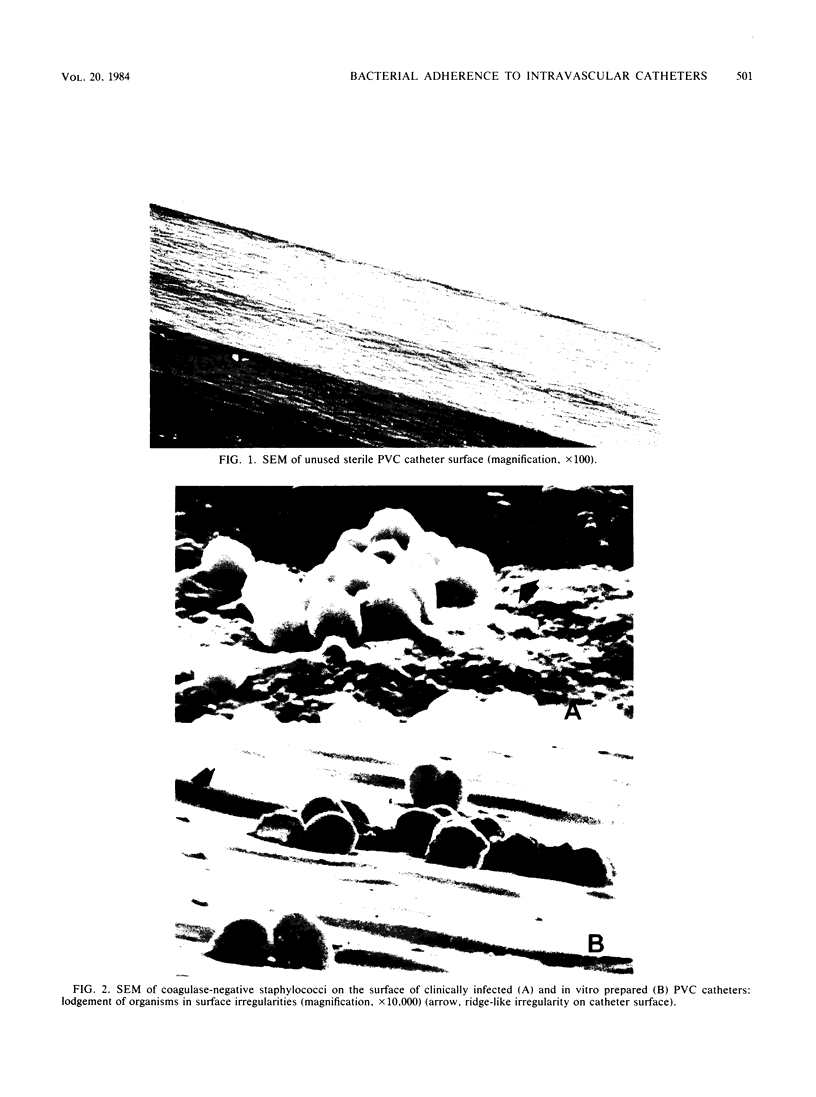


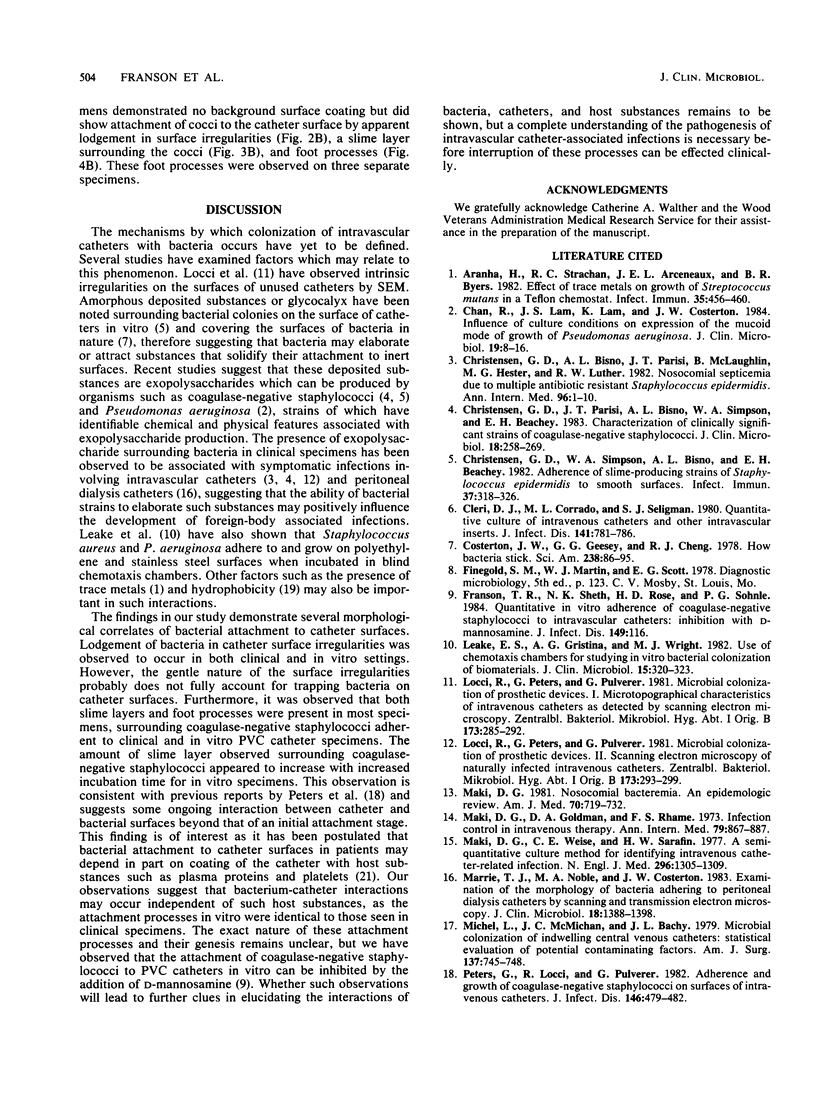
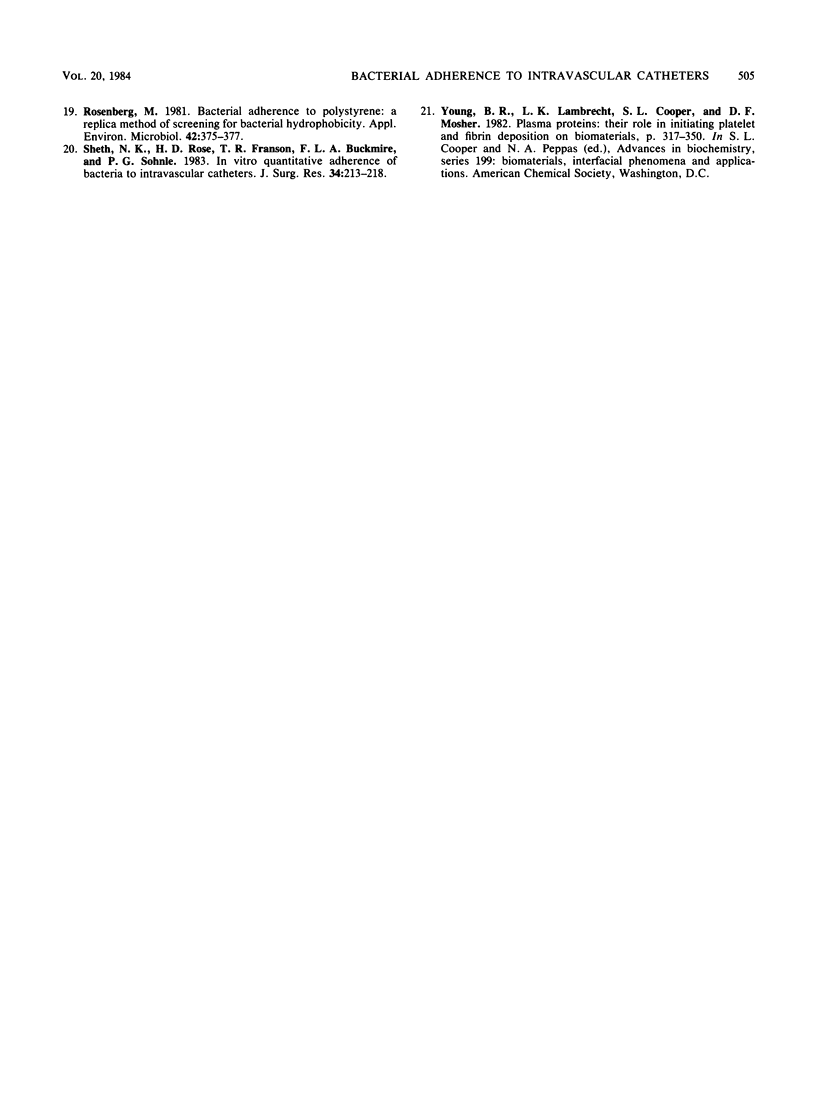
Images in this article
Selected References
These references are in PubMed. This may not be the complete list of references from this article.
- Aranha H., Strachan R. C., Arceneaux J. E., Byers B. R. Effect of trace metals on growth of Streptococcus mutans in a teflon chemostat. Infect Immun. 1982 Feb;35(2):456–460. doi: 10.1128/iai.35.2.456-460.1982. [DOI] [PMC free article] [PubMed] [Google Scholar]
- Chan R., Lam J. S., Lam K., Costerton J. W. Influence of culture conditions on expression of the mucoid mode of growth of Pseudomonas aeruginosa. J Clin Microbiol. 1984 Jan;19(1):8–16. doi: 10.1128/jcm.19.1.8-16.1984. [DOI] [PMC free article] [PubMed] [Google Scholar]
- Christensen G. D., Bisno A. L., Parisi J. T., McLaughlin B., Hester M. G., Luther R. W. Nosocomial septicemia due to multiply antibiotic-resistant Staphylococcus epidermidis. Ann Intern Med. 1982 Jan;96(1):1–10. doi: 10.7326/0003-4819-96-1-1. [DOI] [PubMed] [Google Scholar]
- Christensen G. D., Parisi J. T., Bisno A. L., Simpson W. A., Beachey E. H. Characterization of clinically significant strains of coagulase-negative staphylococci. J Clin Microbiol. 1983 Aug;18(2):258–269. doi: 10.1128/jcm.18.2.258-269.1983. [DOI] [PMC free article] [PubMed] [Google Scholar]
- Christensen G. D., Simpson W. A., Bisno A. L., Beachey E. H. Adherence of slime-producing strains of Staphylococcus epidermidis to smooth surfaces. Infect Immun. 1982 Jul;37(1):318–326. doi: 10.1128/iai.37.1.318-326.1982. [DOI] [PMC free article] [PubMed] [Google Scholar]
- Cleri D. J., Corrado M. L., Seligman S. J. Quantitative culture of intravenous catheters and other intravascular inserts. J Infect Dis. 1980 Jun;141(6):781–786. doi: 10.1093/infdis/141.6.781. [DOI] [PubMed] [Google Scholar]
- Costerton J. W., Geesey G. G., Cheng K. J. How bacteria stick. Sci Am. 1978 Jan;238(1):86–95. doi: 10.1038/scientificamerican0178-86. [DOI] [PubMed] [Google Scholar]
- Franson T. R., Sheth N. K., Rose H. D., Sohnle P. G. Quantitative adherence in vitro of coagulase-negative staphylococci to intravascular catheters: inhibition with D-mannosamine. J Infect Dis. 1984 Jan;149(1):116–116. doi: 10.1093/infdis/149.1.116. [DOI] [PubMed] [Google Scholar]
- Leake E. S., Gristina A. G., Wright M. J. Use of chemotaxis chambers for studying in vitro bacterial colonization of biomaterials. J Clin Microbiol. 1982 Feb;15(2):320–323. doi: 10.1128/jcm.15.2.320-323.1982. [DOI] [PMC free article] [PubMed] [Google Scholar]
- Locci R., Peters G., Pulverer G. Microbial colonization of prosthetic devices. I. Microtopographical characteristics of intravenous catheters as detected by scanning electron microscopy. Zentralbl Bakteriol Mikrobiol Hyg B. 1981;173(5):285–292. [PubMed] [Google Scholar]
- Maki D. G., Goldman D. A., Rhame F. S. Infection control in intravenous therapy. Ann Intern Med. 1973 Dec;79(6):867–887. doi: 10.7326/0003-4819-79-6-867. [DOI] [PubMed] [Google Scholar]
- Maki D. G. Nosocomial bacteremia. An epidemiologic overview. Am J Med. 1981 Mar;70(3):719–732. doi: 10.1016/0002-9343(81)90603-3. [DOI] [PubMed] [Google Scholar]
- Maki D. G., Weise C. E., Sarafin H. W. A semiquantitative culture method for identifying intravenous-catheter-related infection. N Engl J Med. 1977 Jun 9;296(23):1305–1309. doi: 10.1056/NEJM197706092962301. [DOI] [PubMed] [Google Scholar]
- Marrie T. J., Noble M. A., Costerton J. W. Examination of the morphology of bacteria adhering to peritoneal dialysis catheters by scanning and transmission electron microscopy. J Clin Microbiol. 1983 Dec;18(6):1388–1398. doi: 10.1128/jcm.18.6.1388-1398.1983. [DOI] [PMC free article] [PubMed] [Google Scholar]
- Michel L., McMichan J. C., Bachy J. L. Microbial colonization of indwelling central venous catheters: statistical evaluation of potential contaminating factors. Am J Surg. 1979 Jun;137(6):745–748. doi: 10.1016/0002-9610(79)90085-0. [DOI] [PubMed] [Google Scholar]
- Peters G., Locci R., Pulverer G. Adherence and growth of coagulase-negative staphylococci on surfaces of intravenous catheters. J Infect Dis. 1982 Oct;146(4):479–482. doi: 10.1093/infdis/146.4.479. [DOI] [PubMed] [Google Scholar]
- Peters G., Locci R., Pulverer G. Microbial colonization of prosthetic devices. II. Scanning electron microscopy of naturally infected intravenous catheters. Zentralbl Bakteriol Mikrobiol Hyg B. 1981;173(5):293–299. [PubMed] [Google Scholar]
- Rosenberg M. Bacterial adherence to polystyrene: a replica method of screening for bacterial hydrophobicity. Appl Environ Microbiol. 1981 Aug;42(2):375–377. doi: 10.1128/aem.42.2.375-377.1981. [DOI] [PMC free article] [PubMed] [Google Scholar]
- Sheth N. K., Rose H. D., Franson T. R., Buckmire F. L., Sohnle P. G. In vitro quantitative adherence of bacteria to intravascular catheters. J Surg Res. 1983 Mar;34(3):213–218. doi: 10.1016/0022-4804(83)90062-8. [DOI] [PubMed] [Google Scholar]




